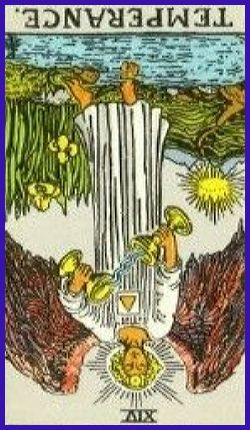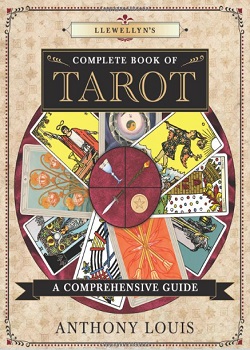Your Chosen Card – Temperance Reversed Rider Waite Deck

When reversed, the Temperance card implies that you are having difficulty finding a golden mean. Confronted by contradictory impulses, you feel at a loss about how to strike an artful balance. You are tempted to go to extremes rather than seek a middle ground of reconciliation. Ponder the words of the philosopher: ‘Moderation in all things, including moderation.’ As Abraham Lincoln cautioned, ‘A house divided against itself cannot stand.’
Keywords Reversed: Immoderation, conflict, incompatibility, excess, imbalance, impatience, going to extremes, lack of self-control, indecision, clashing interests, inconsiderate demands, inability to reconcile opposing forces, irreconcilable differences, all or nothing thinking; ‘its my way or the highway.’
Key XIV: Temperance (Temperance)
Myths/Archetypes: The Centaur. The Alchemist. The Hermaphrodite. The Transsexual. The Creator. The Temperanceist. The Healer. The Inventor. Hegels dialectic.
Dates of Sagittarius: 22 November21 December (tropical); 16 December14 January (sidereal).
Astrology: Sagittarius, the centaur archer (a Fire sign ruled by Jupiter)
Numerology: 5 (Hierophant) = 1 + 4 (Temperance)
14. Temperance: Temperanceful Blending And Reconciliation
When Temperance is reversed you can pretty much take it that life is going well but that’s when life takes us by surprise. If Temperance is unclear it may help to choose a card from the Major Arcana to provide more insight into what it is Temperance is trying to tell you. If you had a particular issue in mind, or want to seek clarification on something else, you can also choose again to get more guidance.

This chosen card is part of your reversed card reading for Temperance using cards from the Rider Waite Tarot Deck. You will find many more tarot pages that will be of great help if you need tarot card meanings. Use the search at the bottom of the page. We have some amazing tarot books for you to browse. Please see below.
Here are some snippets from a few of my favorite books

Book Details
Complete Book of Tarot: Although the tarot originated as a deck of playing cards, it is commonly used today for divination, which we might define as ‘brainstorming with the help of the gods.’ Some people may be put off by the idea of divination, so it is worthwhile to explore the meaning of this term. In Latin, divinus is a word referring to the gods. In ancient times, people believed that certain information, such as knowledge of the future, belonged exclusively to divine beings. Mortals, for their part, developed various methods to petition the gods to share their divine knowledge with humankind, and such methods were called divination.
Complete Book of Tarot: A glance at the four elements reveals that two of the elements, Fire and Air, tend to rise above the surface of the Earth while the other two, Water and Earth, tend to sink below the surface of the Earth. Thus, Fire and Air are considered to be more phallic, centrifugal (thrusting away from a center), and outer directed, whereas Water and Earth are regarded as more receptive, centripetal (pulling toward a center), and inner directed.
- Do get in touch if you looked for Temperance and we don’t have it listed. We would be more than happy to source the information for you. We hope you visit again for more online tarot information!
Complete Book of Tarot: A glance at the four elements reveals that two of the elements, Fire and Air, tend to rise above the surface of the Earth while the other two, Water and Earth, tend to sink below the surface of the Earth. Thus, Fire and Air are considered to be more phallic, centrifugal (thrusting away from a center), and outer directed, whereas Water and Earth are regarded as more receptive, centripetal (pulling toward a center), and inner directed.